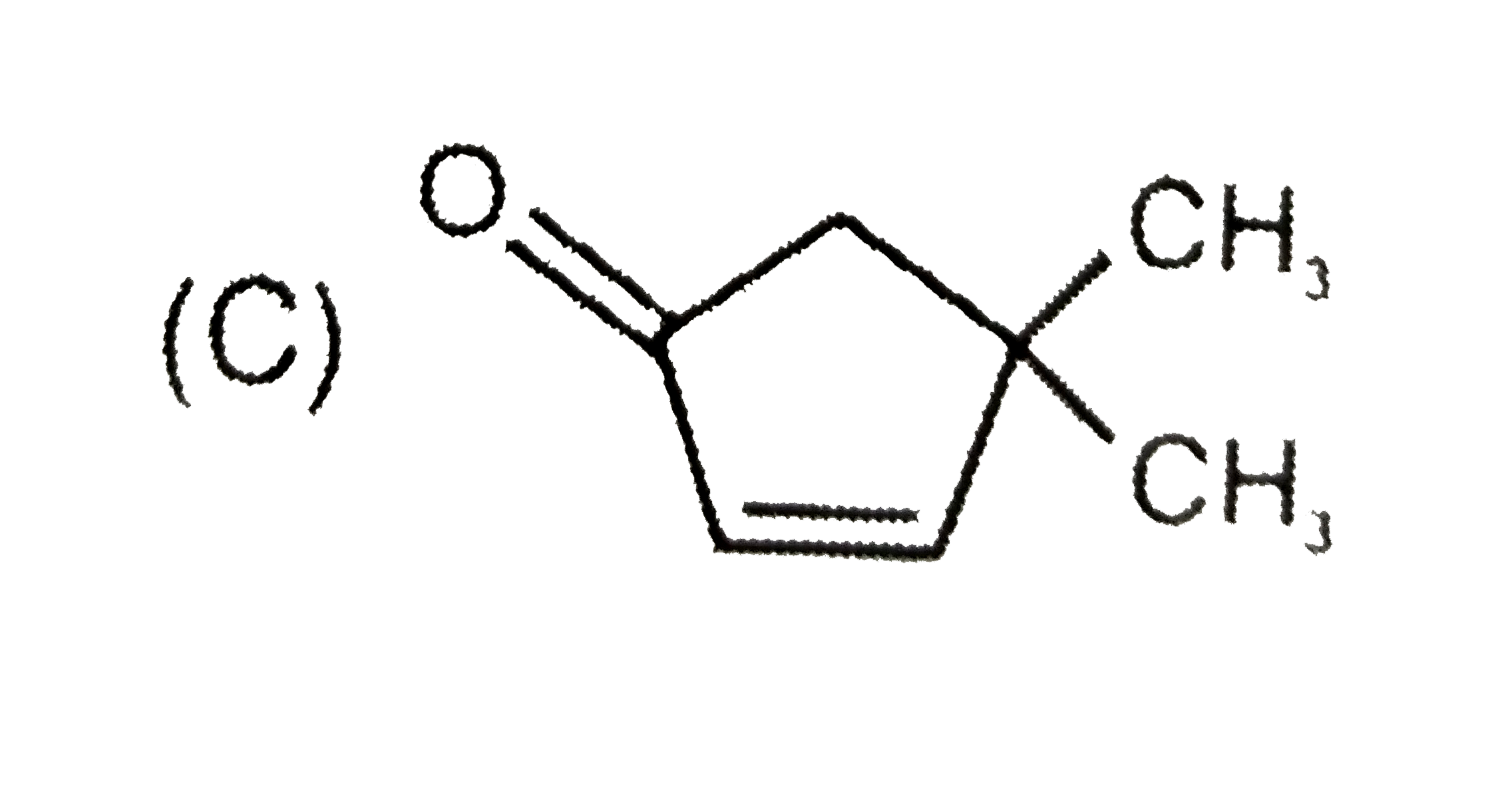product :




The correct Answer is:C
To solve the given problem, we will follow the steps of the aldol condensation reaction. The starting compound is a carbonyl compound with the formula C7H10O, and we will react it with KOH and water, followed by heating.
1. Identify the Starting Compound:
The starting compound is:
CH3C(=O)CH2C(CH3)(CH3)CHO
This compound has a ketone and an aldehyde functional group.
2. Deprotonation by KOH:
When we add KOH, it acts as a base and abstracts a hydrogen atom from the CH2 group adjacent to the carbonyl (ketone) group. This results in the formation of an enolate ion:
CH3C(=O)CH−2C(CH3)(CH3)CHO
3. Nucleophilic Attack:
The enolate ion then attacks the carbonyl carbon of the aldehyde group. This forms a β-hydroxy ketone (aldol):
CH3C(=O)CH(OH)C(CH3)(CH3)CHO
4. Formation of the Aldol Product:
The aldol product can be represented as:
CH3C(=O)CH(OH)C(CH3)(CH3)CH2CHO
5. Dehydration (Heating):
Upon heating, the aldol product undergoes dehydration (loss of water). The hydroxyl group from the β-hydroxy ketone and a hydrogen atom from the adjacent carbon are eliminated to form a double bond:
CH3C(=O)CH=C(CH3)(CH3)C
6. Final Product:
The final product after dehydration is:
CH3C(=O)CH=C(CH3)(CH3)C
This compound has the formula C7H10O.
Summary of the Reaction:
The overall reaction can be summarized as:
CH3C(=O)CH2C(CH3)(CH3)CHOKOH,H2O,Δ−−−−−−−−→C7H10O
The starting compound is:
CH3C(=O)CH2C(CH3)(CH3)CHO
This compound has a ketone and an aldehyde functional group.
When we add KOH, it acts as a base and abstracts a hydrogen atom from the CH2 group adjacent to the carbonyl (ketone) group. This results in the formation of an enolate ion:
CH3C(=O)CH−2C(CH3)(CH3)CHO
The enolate ion then attacks the carbonyl carbon of the aldehyde group. This forms a β-hydroxy ketone (aldol):
CH3C(=O)CH(OH)C(CH3)(CH3)CHO
The aldol product can be represented as:
CH3C(=O)CH(OH)C(CH3)(CH3)CH2CHO
Upon heating, the aldol product undergoes dehydration (loss of water). The hydroxyl group from the β-hydroxy ketone and a hydrogen atom from the adjacent carbon are eliminated to form a double bond:
CH3C(=O)CH=C(CH3)(CH3)C
The final product after dehydration is:
CH3C(=O)CH=C(CH3)(CH3)C
This compound has the formula C7H10O.
The overall reaction can be summarized as:
CH3C(=O)CH2C(CH3)(CH3)CHOKOH,H2O,Δ−−−−−−−−→C7H10O
Topper's Solved these Questions
- CARBONYL COMPOUNDS (ALDEHYDES & KETONES ) & CARBOXYLIC ACID Book:RESONANCE ENGLISHChapter:CARBONYL COMPOUNDS (ALDEHYDES & KETONES ) & CARBOXYLIC ACID Exercise:PART- IV
Explore 13 Videos
- CARBONYL COMPOUNDS (ALDEHYDES & KETONES ) & CARBOXYLIC ACID Book:RESONANCE ENGLISHChapter:CARBONYL COMPOUNDS (ALDEHYDES & KETONES ) & CARBOXYLIC ACID Exercise:Exercise-3
Explore 1 Video
- CARBONYL COMPOUNDS (ALDEHYDES & KETONES ) & CARBOXYLIC ACID Book:RESONANCE ENGLISHChapter:CARBONYL COMPOUNDS (ALDEHYDES & KETONES ) & CARBOXYLIC ACID Exercise:Exercise-2 Part-I
Explore 1 Video
- BIOMOLECULES & POLYMERBook:RESONANCE ENGLISHChapter:BIOMOLECULES & POLYMERExercise:ORGANIC CHEMISTRY(Biomolecules & Polymer)
Explore 34 Videos
- CHEMICAL KINETICSBook:RESONANCE ENGLISHChapter:CHEMICAL KINETICSExercise:PHYSICAL CHEMITRY (CHEMICAL KNIETICS & RADIOACTIVITY)
Explore 49 Videos
Similar Questions
Knowledge Check
CH3−CH2−O∣∣C−CH3∣C∣CH3−CH3PhCO3H−−−−−→A,A will be
ACH3−CH2−O−O∣∣C−CH3∣C∣∣CH3−CH3BCH3−CH2−O∣∣C−O−CH3∣C∣CH3−CH3CCH3−CH2−O∣∣C−CH3∣−∣CH3O−CH3DNone of theseCH3−CH∣Br−CH2−O∣∣C−CH3N2HO(4),ϴOH−−−−−−−−−−−→Δ Product:
A B
B C
C D
D
The IUPAC name of CH3−O∣∣C−C∣C2H5H−C∣CH3H−CH3 is
A3-(Methylethyl) pentan-2-oneB3-(Methylethyl)pentan-4-oneC3-Ethyl-4-methylpentan-2-oneD3-Ethyl-2-methylpentan-4-one
H3CCH3∣−−∣CH3C2H5∣CH−CH∣CH3−OHH⊕−−→△P Product mixture, the product's mixture contains
View SolutionGive the IUPAC names of the following compounds :CH3CH3−CH3∣C∣CHO−CH2CH3
View SolutionGive the IUPAC names of the following compounds :CH3CH3−CH3∣C∣CHO−CH2CH3
View SolutionFor the given four structures , I to IV, which of the following is correct ?
C2H5−CH3∣CH−C3H7(I) CH3−OPC−CH3∣CH−C2H5(II)CH3−OPC−C2H5∣CH−C2H5(III) C2H5−CH3∣CH−C2H5(IV)
View SolutionThe two compounds may be considered as :
CH3−O∣∣C−CH3∣C∣CH3−CH3andCH3−CH3∣CH−O∣∣C−CH2CH3
View Solution
